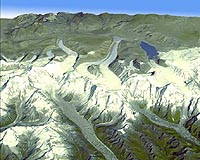| . |  |
. |
Lukla, Nepal (AFP) Aug 30, 2009 Over two decades, Funuru Sherpa has watched the lake above his native village of Dengboche in Nepal's Himalayas grow, as the glacier that feeds it melts. The 29-year-old, who runs a busy Internet cafe for tourists visiting the Everest region, remembers his grandfather telling him that 50 years ago the lake did not exist. "Before, it was all ice," he told AFP in the eastern Himalayan town of Lukla, in the shadow of Mount Everest. "This is proof that the glaciers in the high Himalayas are melting. And that must be because the temperatures have gone up." Scientists say the Imja Glacier above Dengboche is retreating by about 70 metres (230 feet) a year, and the melting ice has formed a huge lake that could devastate villages downstream if it bursts. The trend is not new. Nepal's International Centre for Integrated Mountain Development (ICIMOD), which has studied the Himalayas for three decades, says many of the country's glaciers have been retreating for centuries. But ICIMOD glaciologist Samjwal Ratna Bajracharya said this was now happening at an alarming speed, with temperatures in the Himalayas rising at a much faster rate than the global average. "Our studies of the past 30 years show that the temperatures (in the Himalayas) are rising up to eight times faster than the global average. Melting is taking place higher and faster," Bajracharya told AFP. "The melting of glaciers and formation of glacier lakes is a key indicator of the temperature rise. And lately, we have seen massive ice melt." Nepal has more than 2,300 glacial lakes and experts say at least 20 are in danger of bursting. At almost one square kilometre (0.38 square miles), the Imja lake is the country's second biggest, estimated to hold 36 million cubic metres (47 million cubic yards) of water, and is considered the biggest flood threat. It is a subject close to the heart of Nepalese mountaineer Apa Sherpa, who has climbed Everest a record 19 times. In 1985 Apa Sherpa lost his house and farm when the Dig Tsho glacial lake burst, causing a giant wave to flow down the mountain. Seven people were killed by the flood, which swept away bridges and houses and destroyed a new hydropower station. "For me, climate change is personal," said the climber, who dedicated his latest Everest expedition to raising awareness of the impact of climate change on mountain communities. "There's probably no one who can relate to this issue in the way that I can." Information about how many people would be affected by a glacial lake bursting remains limited, but experts say the floodwaters could reach as far as Nepal's southern planes and beyond. Environment secretary Uday Raj Sharma said last week the bursting of the Imja lake would be like a "Nepalese tsunami," comparing it with the 2004 Indian Ocean disaster in which around 220,000 people died. The government has asked international donors for help in tackling the hazardous glacial lakes, which will be discussed at regional talks here next week aimed at highlighting the dangers climate change poses to the Himalayas. But experts say there are no easy solutions. The mountain communities most at risk are often reluctant to leave their homes, while draining the lakes is expensive and dangerous and does not always work. Ten years ago Nepal launched a three-million-dollar project funded by the Dutch government to lower the water level in the country's biggest glacial lake, Tsho Rolpa, in the eastern Himalayas. The lake had grown from 0.23 square kilometres in 1957 to 1.65 square kilometres in 1997 and threatened villages and a major hydropower plant under construction downstream. Engineers cut a channel 70 metres long and seven metres wide into the side of the lake and successfully lowered the water level, reducing the risk of it bursting its banks. But ICIMOD's Bajracharya said the project was expensive and had only reduced rather than eliminated the risk of a flood. "We spent three million dollars without actually solving the problem," he said, calling on the government to focus instead on creating awareness programmes and early warning systems for communities at risk. Pasang Omo is a father of three who lives in the village of Shomare in the eastern Himalayas, which experts say would likely be wiped out if the Imja lake burst. He agrees that the government has not done enough to help the mountain communities most at risk. "Everyone comes to us and tell us a Glacial Lake Outburst Flood will sweep through our villages. But it doesn't do us any good," said Omo, 45, who works as a porter for trekkers. "It's like telling someone they are sick but not giving them a cure."
Share This Article With Planet Earth
Related Links Beyond the Ice Age
 Himalayan nations to hold first climate talks
Himalayan nations to hold first climate talksKathmandu (AFP) Aug 28, 2009 South Asian ministers will gather in Nepal next week for talks on the threat that climate change poses to the Himalayas and to the 1.3 billion people dependent on water flowing from the mountains. Experts say the Himalayan glaciers are melting at an alarming rate and with months to go before a key summit in Copenhagen, mountain nations are hoping to highlight the myriad of problems facing ... read more |
|
| The content herein, unless otherwise known to be public domain, are Copyright 1995-2009 - SpaceDaily. AFP and UPI Wire Stories are copyright Agence France-Presse and United Press International. ESA Portal Reports are copyright European Space Agency. All NASA sourced material is public domain. Additional copyrights may apply in whole or part to other bona fide parties. Advertising does not imply endorsement,agreement or approval of any opinions, statements or information provided by SpaceDaily on any Web page published or hosted by SpaceDaily. Privacy Statement |